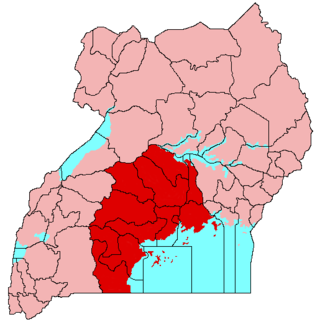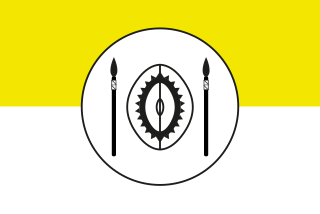
Buganda is a Bantu kingdom within Uganda. The kingdom of the Baganda people, Buganda is the largest of the traditional kingdoms in present-day East Africa, consisting of Uganda's Central Region, including the Ugandan capital Kampala. The 14 million Baganda make up the largest Ugandan region, representing approximately 16% of Uganda's population.
The early history of Uganda comprises the history of Uganda before the territory that is today Uganda was made into a British protectorate at the end of the 19th century. Prior to this, the region was divided between several closely related kingdoms.

The Protectorate of Uganda was a protectorate of the British Empire from 1894 to 1962. In 1893 the Imperial British East Africa Company transferred its administration rights of territory consisting mainly of the Kingdom of Buganda to the British government.

Sir Edward Frederick William David Walugembe Mutebi Luwangula Mutesa II was Kabaka of the Kingdom of Buganda in Uganda from 22 November 1939 until his death. He was the 35th Kabaka of Buganda and the first president of Uganda from 1962 to 1966, when he was overthrown by Milton Obote. The foreign press often referred to him as King Freddie, a name rarely used in Uganda. An ardent defender of Buganda's interests, especially its traditional autonomy, he often threatened to make the kingdom independent both before and after Uganda's independence to preserve it. These firm convictions also later led to conflicts with his erstwhile political ally Milton Obote, who would eventually overthrow him.

Danieri Basammula-Ekkere Mwanga II Mukasa was the 31st Kabaka of Buganda who ruled from 1884 until 1888 and from 1889 until 1897.

Mukono is one of the districts in the Central Region of Uganda. The town of Mukono is home to the district's main commercial center and district headquarters.

Kabaka is the title of the king of the Kingdom of Buganda. According to the traditions of the Baganda they are ruled by two kings, one spiritual and the other secular.
Rashid Kalema Muguluma was Kabaka of the Kingdom of Buganda, from 21 October 1888 until 5 October 1889. He was the 33rd Kabaka of Buganda.

The Chiefdom of Kooki, also known as the Kooki chiefdom, was a pre-colonial African kingdom located within present-day Rakai District of Uganda that existed from approximately 1740 until 1896. The kingdom ceased to exist as an independent state in 1896 when it merged into the British Protectorate of Buganda. Its royal line still continues to this day as a Chiefdom, and is currently led by The Kamuswaga Apollo Sansa Kabumbuli II a hereditary Saza Chief on behalf of the Kabaka of Buganda. In 27 July 2015, the Kooki Kingdom declared independence from Buganda but it wasn't recognized by Buganda or Uganda.

The history of Buganda is that of the Buganda kingdom of the Baganda people, the largest of the traditional kingdoms in present-day Uganda.
Mengo is a hill in Rubaga Division, Kampala, Uganda's capital and largest city. The name also applies to the neighborhood on that hill.
Nakibinge Kagali was Kabaka (King) of the Kingdom of Buganda, between 1524 and 1554 AD. He was the 8th Kabaka of Buganda.
Namirembe is a hill in Kampala, Uganda's capital and largest city. It is also a common name given to girls in several Baganda clans. Namirembe comes from the Luganda word "mirembe" meaning peace. Namirembe loosely translates into Full of Peace. Legend has it that this hill was a gathering place for celebrating peace or war victories.

The Kasubi Tombs in Kampala, Uganda, is the site of the burial grounds for four kabakas and other members of the Baganda royal family. As a result, the site remains an important spiritual and political site for the Ganda people, as well as an important example of traditional architecture. It became a UNESCO World Heritage Site in December 2001, when it was described as "one of the most remarkable buildings using purely vegetal materials in the entire region of sub-Saharan Africa".

The Baganda also called Waganda, are a Bantu ethnic group native to Buganda, a subnational kingdom within Uganda. Traditionally composed of 52 clans, the Baganda are the largest people of the Bantu ethnic group in Uganda, comprising 16.5 percent of the population at the time of the 2014 census.

Kyankwanzi District is the westernmost district in the Buganda Region of Uganda and Buganda Kingdom, bordering Bunyoro. The district headquarters are in Butemba Town.
Buruuli (place) is a general term used to refer to the area where the Baruuli live. It is located in the district of Nakasongola, as well as in Bugerere Kayunga District. The Baruuli speak the Ruruuli language, a Bantu language closely related to Lunyala, a language spoken by the Banyala of Kayunga District. The Baruuli are ruled and governed by Ssabaluuli Mwogezi, who was crowned as their Kabaka by the president of Uganda Yoweri Kaguta Museveni.

The Tooro people, also known as Batooro or Toro people are a Bantu ethnic group, native to the Tooro Kingdom, a subnational constitutional monarchy within Uganda.
The Baruuli or Baluuli, are a Bantu ethnic group native to Bunyoro-Kitara, a subnational kingdom within Uganda. They stay in an area called Buruuli. They share a common ancestry with the Banyala.
The Kabaka crisis was a political and constitutional crisis in the Uganda Protectorate between 1953 and 1955 wherein the Kabaka Mutesa II pressed for Bugandan secession from the Uganda Protectorate and was subsequently deposed and exiled by the British governor Andrew Cohen. Widespread discontent with this action forced the British government to backtrack, resulting in the restoration of Mutesa as specified in the Buganda Agreement of 1955, which ultimately shaped the nature of Ugandan independence.












